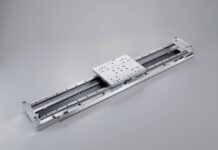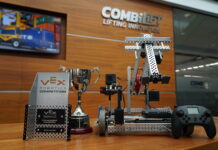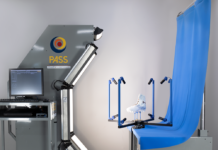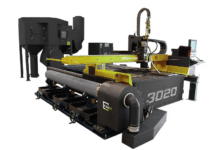Spring and fall bring great weather, but they also bring a problem all too familiar to industrial facility managers: warm, humid days and cool nights – a recipe for condensation.
Condensation is more than just an annoyance. It can damage or destroy inventory and equipment by causing rust, mold and mildew. The National Association of Corrosion Engineers reports that $17.6 billion worth of metal product is lost to corrosion in the production and manufacturing sectors each year.
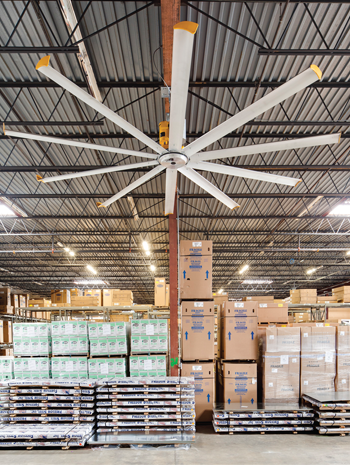 Additionally, moisture may pool on concrete floors, creating slip-and-fall hazards that can carry heavy human and financial costs. Compensation and medical costs associated with employee slip-and-fall accidents cost approximately $70 billion annually, according to the National Floor Safety Institute, which also reports that slips and falls are the leading cause of workers’ compensation claims.
Additionally, moisture may pool on concrete floors, creating slip-and-fall hazards that can carry heavy human and financial costs. Compensation and medical costs associated with employee slip-and-fall accidents cost approximately $70 billion annually, according to the National Floor Safety Institute, which also reports that slips and falls are the leading cause of workers’ compensation claims.
Facility managers have long relied on high volume, low speed (HVLS) fans to combat condensation in unconditioned spaces, but one fan manufacturer is taking guesswork out of the equation. Big Ass Fans, headquartered in Lexington, Kentucky, has developed an automated controller that incorporates overhead fans, heaters and ventilation systems to prevent condensation before it occurs.
“Trying to control condensation manually is difficult, because temperature and humidity are so unpredictable. You never know when a condensation event might occur,” said Stephen Bird, product manager at Big Ass Fans. “Even TV meteorologists are wrong half the time.”
Big Ass Fans’ new condensation control system, Dewtect, combines an array of temperature and humidity sensors that use proprietary algorithms to form an entirely automated condensation abatement system, using equipment most facilities already own.
“Rather than relying on fans to dry condensation, which the industry has done for years, Dewtect can prevent it from happening in the first place,” Bird said.
How Condensation Forms
Condensation forms because cold air doesn’t hold as much moisture as warm air. When warm, humid air contacts a cold surface and gets colder, it can eventually reach a point of saturation – the dew point. When the air temperature falls below the dew point, the air loses its ability to hold moisture, depositing it on the colder surface.
In spring and fall, it’s common for the surface temperature of floors, products and equipment to drop below the dew point at night. When warmer, wetter air moves in during the day, a slick layer of condensation can form over cooler objects.
In fall and winter, it’s also common for condensation to form on product that has been moved from a cold truck into a heated warehouse. In spring, condensation is especially problematic for industrial facilities because large, dense objects are slow to react to temperature changes. A roll of sheet metal might hold a cool temperature for days or weeks after the weather warms up. It could take a month or more of warm weather for the core temperature of a concrete slab to rise above the dew point.
In the past, controlling condensation has been done mainly in one of two ways. The first is to reduce the dew point using an HVAC or dehumidification system. These systems can be expensive and energy-intensive, and usually require costly insulation and sealing upgrades to be completely effective.
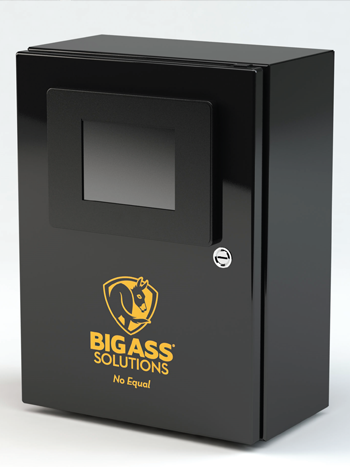 The other option is to maintain or quickly increase the surface temperature of the object above the dew point, or dry any moisture that forms, with air movement. Many industrial facilities have used this method for years. However, most facilities use fans to dry condensation reactively, and don’t realize fans also help prevent it altogether.
The other option is to maintain or quickly increase the surface temperature of the object above the dew point, or dry any moisture that forms, with air movement. Many industrial facilities have used this method for years. However, most facilities use fans to dry condensation reactively, and don’t realize fans also help prevent it altogether.
How Dewtect Improves the Process
Adjusting temperature as humidity changes is key to preventing condensation, but because weather patterns are unpredictable, and condensation events often occur outside of work hours, having employees on hand at all times to monitor the weather and adjust the fans isn’t feasible.
Big Ass Fans’ Dewtect system uses indoor and outdoor temperature and humidity sensors, and a surface temperature sensor, to monitor trending conditions and prevent condensation from forming. It does so by automatically engaging fans, vents and heaters to hold the surface temperature to within 5°F of the air temperature. Preventing condensation means less product loss, fewer shutdowns and safer employees.
It can also help sell a building; recently the owners of a vacant distribution center in Georgia installed Dewtect after the facility went unleased for five years. Georgia’s humid temperatures turned the floor into a slick safety hazard, which turned off perspective renters. After installing Dewtect, the facility is now leased to a multimillion-dollar retailer.
“Nobody’s going to move into a building with sweaty floor issues, environment issues or contamination. They’re not going to take that chance,” said David Cole, vice president of special operations of NAI Brannen/Goddard LLC. “With Dewtect, we can show that we’ve taken care of the floor. Big Ass Fans interrupted the moisture condensing cycle, the kind of rainforest environment that was existing in the facility.”
Dewtect has also shown it can reduce the number of condensation events affecting steel products by approximately 75 percent. Still, dramatic spikes in humidity can cause condensation to form in unconditioned spaces. When that happens, the system automatically ramps the fans’ speed up to quickly dry the moisture and reduce the impact of condensation.
“The future of business is controls and automation. More and more managers are striving to create smarter facilities,” Bird said. “With Dewtect, we’ve created an automated, easy-to-use solution to a problem that has plagued industrial facilities for decades.”

